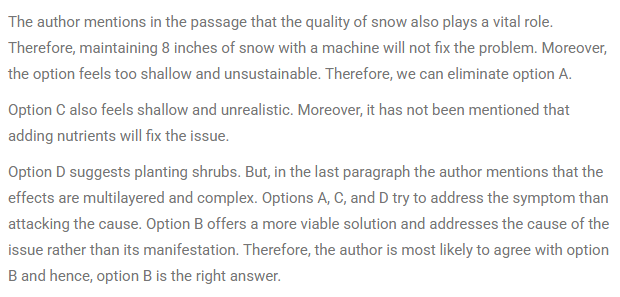CAT RC Questions | CAT RC Based on Natural Science questions
FundaMakers is the Best CAT Online Coaching In India. Now prepare for CAT anytime with FundaMakers. We provide well-ordered syllabus coverage for both offline and online CAT preparation batches. FundaMakers brings to you the power-packed, well-structured CAT previous year question bank with more than 4000+ CAT Past Year questions. In the VARC section, one of the most frequently asked questions is from the topic- Reading Comprehension. Reading Comprehension turns out to be an important part of the VARC section from which over 60-70% of the questions are based on RC in the CAT Exam.
FundaMakers as a team has taken a painstaking step to bring you all the video solutions of the Reading Comprehension asked in the Previous Year CAT exam. CAT question bank offered by FundaMakers is a power-packed topic-wise compilation of the entire CAT previous year questions. Questions from the Reading Comprehension topic are some of the most scoring questions in the VARC section. To maximize your CAT score make use of FundaMakers CAT Question Bank. “Questions from CAT previous years” examination papers have been incorporated. Let’s get started with CAT Past Year Reading Comprehension Questions
Comprehension
Directions for question: Read the passage carefuly and answer the given questions accordingly
During the frigid season... it's often necessary to nestle under a blanket to try to stay warm. The temperature difference between the blanket and the air outside is so palpable that we often have trouble leaving our warm refuge. Many plants and animals similarly hunker down, relying on snow cover for safety from winter's harsh conditions. The small area between the snowpack and the ground, called the subnivium... might be the most important ecosystem that you have never heard of.
The subnivium is so well-insulated and stable that its temperature holds steady at around 32 degree Fahrenheit (0 degree Celsius). Although that might still sound cold, a constant temperature of 32 degree Fahrenheit can often be 30 to 40 degrees warmer than the air temperature during the peak of winter. Because of this large temperature difference, a wide variety of species...depend on the subnivium for winter protection.
For many organisms living in temperate and Arctic regions, the difference between being under the snow or outside it is a matter of life and death. Consequently, disruptions to the subnivium brought about by climate change will affect everything from population dynamics to nutrient cycling through the ecosystem.
The formation and stability of the subnivium requires more than a few flurries. Winter ecologists have suggested that eight inches of snow is necessary to develop a stable layer of insulation. Depth is not the only factor, however. More accurately, the stability of the subnivium depends on the interaction between snow depth and snow density. Imagine being under a stack of blankets that are all flattened and pressed together. When compressed, the blankets essentially form one compacted layer. In contrast, when they are lightly placed on top of one another, their insulative capacity increases because the air pockets between them trap heat. Greater depths of low-density snow are therefore better at insulating the ground.
Both depth and density of snow are sensitive to temperature. Scientists are now beginning to explore how climate change will affect the subnivium, as well as the species that depend on it. At first glance, warmer winters seem beneficial for species that have difficulty surviving subzero temperatures; however, as with most ecological phenomena, the consequences are not so straightforward. Research has shown that the snow season (the period when snow is more likely than rain) has become shorter since l970. When rain falls on snow, it increases the density of the snow and reduces its insulative capacity. Therefore, even though winters are expected to become warmer overall from future climate change, the subnivium will tend to become colder and more variable with less protection from the above-ground temperatures.
The effects of a colder subnivium are complex... For example, shrubs such as crowberry and alpine azalea that grow along the forest floor tend to block the wind and so retain higher depths of snow around them. This captured snow helps to keep soils insulated and in turn increases plant decomposition and nutrient release. In field experiments, researchers removed a portion. of the snow cover to investigate the importance of the subnivium's insulation. They found that soil frost in the snow-free area resulted in damage to plant roots and sometimes even the death of the plant.
CAT/2017.2
Question . 82
Based on this extract, the author would support which one of the following actions?
Explanatory Answer
Method of solving this CAT RC Question from RC Based on Natural Science question
Option B is correct

Hey! Worried about IIM calls due to your marks in 10th,12th, and Graduation?

Don't worry! Know your chances of getting an IIM Call based on your profile with our Profile Professor: https://fundamakers.com/profile-professor/

5 Must- NOT-Dos during CAT Preparation.
- Do not treat CAT as 'Everything'.
- Do not quit your job for CAT exam preparation.
- Learning till The Eleventh hour instead of doing proper revision.
- Not checking the syllabus thoroughly.
- Piling up multiple books.
Common mistakes made by CAT aspirants during preparation.
FundaMakers- Best CAT Online Preparation Institute in India
Best Online and Offline CAT Coaching in Lucknow.
For any CAT Preparation related query, reach out to us at 9598333344.